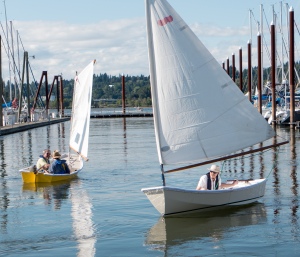The first half of Sunday was taken up with a retirement celebration. It is telling when we find that retirement celebrations are a big item on our social calendars. The main problem is that it was not our retirement celebration. That is OK because Gypsy is not done yet and the day jobs are still a necessity. Much of the rest of Sunday was spent working on getting Gypsy ready for that glorious day. We epoxy coated the plywood parts that will form the port settee.


Where do the dinghys come in? Bill had some System 3 epoxy left from when he made our Chameleon hard dinghy. It is a really cool two part dinghy that we can store on deck. So we used that to coat the wood. System 3 is fine except that it cures really slowly. On Monday morning some of the parts were still tacky. With cooler weather coming he decided to go back to using West epoxy. It always hardens overnight.
The rethinking part of the weekend involved the refrigerator. We were originally going to put it back where the dry pantry had been. This space, however had the disadvantage that it started out deep and narrow and got narrower the farther aft it went. Sometimes the simpler solutions are actually simpler. Put it back in the space it had been, but with more insulation. The dry pantry can go back where it was, slightly smaller, but without all the fiddly shelves. Bill’s Monday morning project (while Nina was off knitting) was to make a mock up of the new icebox out of cardboard. Insulating a boat fridge is no simple thing. Ideally you want six inches of insulation under it, with four inches on all sides, including the hull side, which curves in two directions (toward the after end of the boat and downward toward the keel). The cardboard model gave us an idea of how it would fit in the space so we could figure out if it would allow us to put enough insulation around it. The old refrigerator was an energy hog so efficiency is a top priority. The card board box looks like it will work with a couple of minor adjustments.

We had errands to run to do stuff like shop for groceries, so late afternoon found Bill fitting our templates for hatch board sliders. Gypsy has doors for the companionway hatch, the main entry to the cabin. Doors are fine for inshore sailing, but they are not safe offshore, no matter how red they are. At sea, you want nice strong wave resistant hatch boards. The masonite templates finally fit the way we wanted them, so now we can head back up to Becker’s to make them out of stainless steel and get them shiny. Nina’s project there will be more rub strips so the dock lines do not rub through our new paint.
Retooling involved replacing our dying battery powered drill with an electric drill. This will also have the advantage that it’s a poor-man’s stand in for a Makita grinder. Nina discovered that an orbital sander does not have enough umph for grinding down old fiberglass resin. We got a sander attachment so that she can sand where we will be tabbing in the port settee.
Our other new tool is a Sailrite sewing machine. This means that Nina will seriously have to figure out the whole interior color thing so she can get going on making new cushions for the cabin. We’ll need new seat cushions as well as new backrest cushions. And then there’s throw pillows, curtains, and where does it end? This will clearly involve more thought than “it was on sale and it has a nautical theme.”
Welcome to the Sailrite club!
LikeLike
Bill,
Weâre finding Velicâs new icebox quite successful. Ice stays ice for days! Ice cold G&Tâs or martinis âshaken not stirredâ are possible daily!
Insulation is three inches of the grey isocyanate foam, foil faced, from Home Despot AND stock vacuum panels from R-Parts. Each cut edge of foam is taped with the very precious mylar tape from Premier Rubber to seal out moisture. However, the center panel (layer 2) is comprised of the vacuum panel surrounded by foam panels, kind of like a foam frame around the vacuum panel. This protects the vacuum panel and allows use of the stock shapes. This is on three of the five side. I left the bottom and the back only foam with no vacuum panels, thinking that the bottom needed to be really stout to support weight and the back available to install refrigeration later without puncturing the vacuum panel. Doing it again, I would add vacuum panels on all sides. Foam is stacked alternately, like brickwork at a corner, so there is no continuous gap from outside to inside. All is locked into place with 2 part pour-in foam, which also absorbs the contours of the hull shape, fills in minor gaps, fills in the inevitable gap between the top edges of the foam and the underside of the counter top, etc. Pour foam r-value approximates the isocyanate foam and is used by professional insulators in similar situations. Good luck, it will be great.
Randy
LikeLike
Part of the reason I like to push ahead and start working on things like the refrigerator even though we aren’t ready to install it is to get the creative process going. Building the cardboard box not only helps me to visualize the installation it also give me all sorts of ideas of how I want to do the installation. I have made more progress in the last couple of days than I did in the last six months of just thinking about it in the abstract.
LikeLike
Wow! When do you open your redesign shop with custom pillows etc?
LikeLike